Click Here to Download PDF Version

Telehealth Newsletter
Official Newsletter of Tamil Nadu Chapter of Telemedicine Society of India
TN – TSI invites all the TSI Chapters and Members to submit information on their upcoming Webinar or Events (50 words), News related to Telemedicine (200 words) or short articles (500 words) for the monthly e-newsletter. |
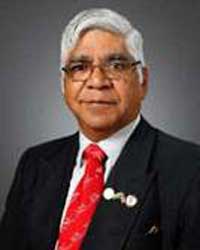 Technology in Telehealth
Technology in Telehealth
Prof. K. Ganapathy
Past President, Telemedicine Society of India, Neurological Society of India & Indian Society for Stereotactic & Functional Neurosurgery | Former Secretary general Asian Australasian Society of Neurological Surgery | Hon Distinguished Professor The Tamilnadu Dr MGR Medical University | Formerly Adjunct Professor IITM and Anna University | Director Apollo Telemedicine Networking Foundation & Apollo Tele Health Services
There is an erroneous perception that widespread adoption, upscaling and deployment of Telehealth is solely related to availability of cost effective, affordable, accessible, user friendly technology. There is no doubt that technology acceptance and behavioral modification, which we are witnessing particularly after the onset of COVID-19, has a major role to play. “ Customer delight” is what every e Commerce platform aims for. The Amazons and Flipkarts and Googles of the world package their products in such a way that even octogenarians from rural backgrounds get hooked to the incredible experience. Whom are we selling telehealth to? Who needs to get “ hooked on” to experience virtual remote health care. How do you convince a worried or sick patient tens, hundreds thousands of kilometers away that the specialist on the screen can do as good a job or even better than if he is holding your hands directly. How do you excite every individual doctor to evangelise Telehealth. This will happen only when his/her patient is convinced that telehealth is as good or better than a face to face consultation 5G, bandwidth of 100 Mbps, a 55” hi resolution screen, a future ready voice activated EMR where images uploaded with ease at the remote end can be digitally manipulated by the consultant, playing videos, a wide choice of highly secured payment gateways etc etc – the list can be never ending —– all this hi tech no doubt will help, but are we not missing the wood for the trees.
What does a patient using Telemedicine really want – even in 2021 . He wants TLC ( Tender Loving Care) “Listen, listen, listen he is telling you the diagnosis” said Sir William Osler 150 years ago. When I give a teleconsult I still listen!! Patients do not care how much you know. They want to know how much you care. Healthcare is personal – it is very hard to feel your experience was excellent, when those treating you don’t introduce themselves, or make eye contact, or say what they are doing to you and why. The doctor’s body language says it all. No AI, no technology will ever substitute for a doctor who empathises, sympathises with his far away patient, wiping the patients tears albeit virtually.
Alas the powers that be, including teleconsultants forget that providing remote health care is not like selling/ buying a pizza online or booking a train ticket. Technology in healthcare should only be a tool, a means to achieve an end, not an end by itself. Technology helps in producing remarkable solutions. Sometimes after this we go in search of problems! Lars Leksell the inventor of the Gamma Knife famously remarked half a century ago –“ A fool with a tool, is still a fool”. I belong to the BC era – not Before Covid but before Computers. Yes I am a technology buff. I even brought out a special edition for the journal Neurology India on “Extra Terrestrial Neurosciences” – the ultimate in Technology. Over the last 21 years when I first started Telemedicine, it has been my privilege to see the radical transformation and the exponential growth of Remote Health care . I am optimistic that soon Telehealth will be centre stage in the core of the health care delivery system. This phenomenal growth is no doubt a direct bye product of technological advances . An app a day may keep the doctor far far away but I would still like my tech savy doctor to be commiserating, to understand what I want so that he will prescribe the right apps for me !! “ Customer delight” is the only way that Telehealth will truly come centrestage and be integrated into the core of the health care delivery system. Worldwide remote health care is driven by technologists, software/ hardware entrepreneurs, communication engineers, mobile network operators, CEO’s of start ups. Manufacturers of peripheral medical devices, wearables etc. During the last 21 years 95% of the numerous talks I have given have been organized by the Telemedicine ecosystem!! Medical colleges, medical associations, clinical societies do not include Telehealth in any CME program. It is extremely unusual to find a clinician giving up a medical or surgical career to embrace telehealth .
The clinician should be the first among equals if patients are to get excited about telehealth abd take the initiative requesting his/ her doctor to appear on the screen. Circumstances and necessity will make doctors understand that this tool for connecting, ensuring a continuum of care will no longer be a choice but will become a differentiator The wrioting is on the wall !

Telemedicine Society of India and Practo launch ‘Rise of Telemedicine – 2020’ report
Dr. Neelesh Bhandari, MBBS (AFMC), MD (Pathology)
Head, Doctor Relations and Engagement | Former Founder and CEO, Healtho5 Solutions Private Limited | Former Chairman, Social Media Committee, Indian Association for Medical Informatics.
Summary: A joint collaboration with the Telemedicine Society of India (TSI), the report highlights the emergence of telemedicine in India, the reasons behind its meteoric rise amid the pandemic, and the advantages it can continue to offer in a post-COVID world.
The report was launched at Telemedicon 2020, by Col. (Dr.) Ashvini Goel, President, Telemedicine Society of India (TSI) in the presence of industry leaders – Dr. Alok Roy, Co-Chair, FICCI Health Services Committee and Chairman, Medica Group of Hospitals, Dr. Girdhar Gyani, Director-General, Association of Healthcare Providers (India), Dr. Vijay Agarwal, President, Consortium of Accredited Healthcare Organizations (CAHO).
The sense of urgency created by the COVID-19 pandemic has spurred medical establishments to overhaul their healthcare delivery systems in pursuit of maximizing patient care and minimizing the risk of infection. This accelerated the adoption of telemedicine practices in India, effectively mitigating the impact of the pandemic while laying the foundation for an innovation-led, patient-centric healthcare system in a post-COVID world.
By tracing the trajectory of the meteoric rise of telemedicine in India since the outbreak, this report by Practo and TSI, launched at Telemedicon 2020, has attempted to recapitulate the key factors contributing to this spike and its long-term benefits.
Commenting on the report, Col. (Dr.) Ashvini Goel, President, Telemedicine Society of India, said, “To witness the significant growth of telemedicine in the past few months has been overwhelming. In a short span of time, the digital health space has evolved and online consultations have become the spine of healthcare delivery systems globally. The pandemic has only allowed us to reiterate our vision for future healthcare that’s convenient, accessible, and affordable for a billion+ Indians.”
Adding to that, Dr. Alok Roy, Co-Chair, FICCI Health Services Committee and Chairman, Medica Group of Hospitals, said, “TSI-Practo telemedicine report is like the Harry Potter magic portal, showing both current and future realities; a step in the right direction will transform the way healthcare is accessed forever.”
Extensively researched and backed by insights culled from the experience of crores of Indians who used Practo between March 2020 and November 2020, this report provides valuable information and factual evidence for all stakeholders of the healthcare ecosystem seeking to understand the role and impact of telemedicine in India.
Shashank ND, CEO & Co-Founder, Practo, said, “Our aim with this report is to ignite meaningful discussions around telemedicine as a critical first step towards establishing more collaborations among stakeholders, tied by a common commitment to one industry. We have tried to cover all aspects of the upward trajectory taken by telemedicine during the pandemic, and the direction it is expected to take in a world no longer under the threat of COVID-19 by carefully analyzing data captured since the outbreak.”
Key insights from the report:
- Physical appointments went down by 32%
- Visits to secondary care specialists like neurosurgeon, somnologist, cardiologist, and oncologist grew dramatically
- 3x increase in the number of people using online consultations
- 26% of the consultations were with GPs, followed by Dermatology (20%) and Gynecology (16%) and others like Gastroenterology, ENT, and Pediatrics stood at 7% each
- The fastest-growing health concerns included ophthalmology, ENT, orthopedics, pediatrics, and gastroenterology
- Delhi, Mumbai, and Chennai saw an average of 16x growth in queries for ENT specialization
- Non-metros saw the highest growth of 7x in online consultations, as compared to the same period in the previous year
- During the same period last year, the split between metro:non-metro for online consultations stood at 75:25. This year, it is 60:40, demonstrating that the number of online consultations from non-metro cities is on the rise
- Tier 2+ cities like Manjeri, Arrah, Balasore, Etah, Orai, Khopoli, Jagtial, and Shivpuri used telemedicine for the first time in this time period
- Cities like Meerut, Jammu, Srinagar, Nellore, Kochi, Gorakhpur, Kakinada, Tirupati, Bhagalpur, Gaya, and Shimoga recorded a 10x growth
- Non-metros saw the highest growth of 7x in online consultations, as compared to the same period in the previous year
- During the same period last year, the split between metro:non-metro for online consultations stood at 75:25. This year, it is 60:40, demonstrating that the number of online consultations from non-metro cities is on the rise
- Tier 2+ cities like Manjeri, Arrah, Balasore, Etah, Orai, Khopoli, Jagtial, and Shivpuri used telemedicine for the first time in this time period
- Cities like Meerut, Jammu, Srinagar, Nellore, Kochi, Gorakhpur, Kakinada, Tirupati, Bhagalpur, Gaya, and Shimoga recorded a 10x growth
- Among metros, Chennai witnessed the highest growth of 4x as compared to the previous year
- Bengaluru, Delhi-NCR, Mumbai, Pune, Hyderabad, and Kolkata grew by more than 300% as compared to last year
- More and more elderly people are now getting used to technology
- There was a 502% spike in online consultations from people above the age of 50 during this crisis, who contributed to 12% of overall consultations, as compared to just 5% the previous year
- More women are going online
- Last year the men:women ratio stood at 75:25, while this year it’s 68:32
- Gynecologists and General Physicians were two of the most consulted specialists by women in 2020
- Online mental health consultations and queries continued to rise during this period
- There was a 302% increase in overall mental health-related queries
- Women contributed to 33% of overall queries for mental health specialists
- More consultations at late hours
- 25% of online consultations were recorded between 10 pm and 4 am when people are not burdened with work responsibilities
- One of the top specialties consulted during late-night hours was Psychiatry
- Preferred day(s) to consult doctors online were Tuesdays, Wednesdays, Saturdays, and Sundays, while Saturdays, Sundays, and Mondays were preferred for in-person appointments
To know more about Telemedicine and its evolution post the COVID-19 outbreak, please refer to the report here – LINK
Apollo Tele Health – Teleconsultations during COVID-19
Dr. Ayesha Nazneen, Apollo Tele Health
Mr. Vikram Thaploo, Apollo Tele Health
The epidemic of 2019 novel coronavirus (COVID-19) has expanded from Wuhan throughout China and is being exported to a growing number of countries including India. In India, pandemic created unrest amongst the population and uncertainty towards medical services accessibility. Government of India realising the potential of Telemedicine, issued guidelines in March 2020 to address many of the key challenges in providing health services during the outbreak of COVID-19.
Apollo Tele health being the leader in Telemedicine, has created an impact by reaching out to the populace during and post COVID-19 lockdown by providing real time Teleconsultations in 16+ specialties covering 28 states of India. During lockdown, services were provided for COVID-19 screening, counselling, treatment and referral by bringing doctor at their home through Teleconsultations if not would have remained deprived from treatment. Teleconsultation services helped them to overcome the challenge of health services accessibility. The services did not limit to the COVID-19 conditions but largely catered to the patients at risk with other health conditions. It provided equal opportunity to all men, women, children and geriatric population overcoming the barriers of lockdown.
The Public Private Partnership projects with multiple state governments of India, enhanced Apollo Tele Health’s capacity to provide Telemedicine services at government health facilities – UPHCs, PHCs and CHCs to both COVID-19 and non COVID-19 conditions during pandemic and touched 460000+ through Teleconsultations.
Highlighting one of the initiatives from many projects, Government of Madhya Pradesh approached Apollo Tele Health to activate (Sanjeevani Tele Health service) Doc on Call with a dedicated Toll-Free number for the entire population of Bhopal and Indore districts and later extended to all districts of Madhya Pradesh for the month of April and May 2020. It covered health related consultations including suspected cases of COVID-19 and essential Non COVID-19 cases ranging from simple infections to chronic diseases and post-surgical follow ups. The consultations were provided by General Physicians and Specialist doctors. Sanjeevani Tele Health service has been widely promoted by Government of Madhya Pradesh, through local newspapers, digital and social. It started with 9 specialities and later with increased demand extended to 11 speciality Teleconsultation services. Most of the consultations were audio but provision of video consultation was also made available based on patient need and clinical judgement of doctor. Suspected COVID-19 and high-risk cases were referred to Government facilities for immediate action. Total 8,600 patient availed the services from GP and specialist doctors. This service reached out to 12 % elderly and vulnerable population of the total patient who availed services.
Apollo Tele Health’s through one of its service “Doc on Call” provided Teleconsultation and counselling services to 2200+ COVID-19 positive cases and 40000+ suspected cases. It helped them to get treated without stepping out from their home. It also helped them to overcome the myths of COVID-19 and face the challenge with confidence. Non COVID-19 patients benefited at large by taking consultation from home without exposing to the risk of COVID-19. The patient feedbacks were positive, one of the patients said “I am so fortunate to avail Doc on Cell service. It felt very personal and professional. I was impressed that the doctor took time to understand my condition. I never imagined; I will beat COVID-19 through virtual consultations.
Apollo Tele Health has helped to transform and showed the path to deliver technology enabled Telemedicine services during lockdown. The enormous impact Apollo had in lives with treatment and suffering eased during pandemic, further strengthen its commitment to provide Telemedicine services in the years ahead.
The AmbuPod Project: Practical application of robotics in Rural Healthcare in India
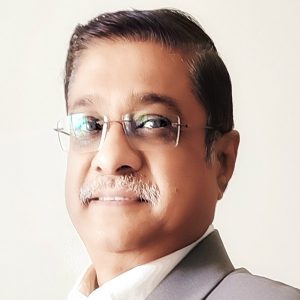 Lavanian Dorairaj
Lavanian Dorairaj
Director, LYNK AmbuPod Pvt Ltd | Certified HL7 and DICOM Specialist | Past Deputy Director, Medical Services, IAF | director@ambupod.com
The AmbuPod project is a highly affordable, mass-production model for rural healthcare. It is a telemedicine supported, primary care mobile clinic that provides diagnostic, preventive and curative care along with its own ambulance with a setup cost of less than Rs 1 lakh per village. The ability to provide 6-days-a-week care to EVERY village within its jurisdiction is a powerful capability that is provided by almost no other such project at the price-point of the AmbuPod project.
The AmbuPod is fully equipped with diagnostics, medical and life-saving equipment to cater to mainly primary and preventive care. However, with the advent of 5G and the possibility of real-time remote instrumentation, it is the opinion of this author that the time is now ripe to apply real-time robotic telemedical instrumentation into rural care so as to provide the remote doctor the ability to remotely image, manipulate and, as we gain more experience, actually carry out remote procedures.
Robotics has traditionally been an area of esoteric and expensive research and work and mostly carried out in the US and the UK. The excellent work done by Boston Dynamics, an American engineering and robotics design company comes to mind. This author feels that it is now time to bring such technologies to the common man while also lowering costs to ensure true affordability. India with its numerous IITs and other centres of excellence could support us in this endeavour. If ISRO could successfully launch a satellite to reach Mars successfully in the verry first attempt, and that too, with a budget 1/10th of that spent by NASA for the same job, I do not see why we cannot take remote healthcare robotics to rural India.
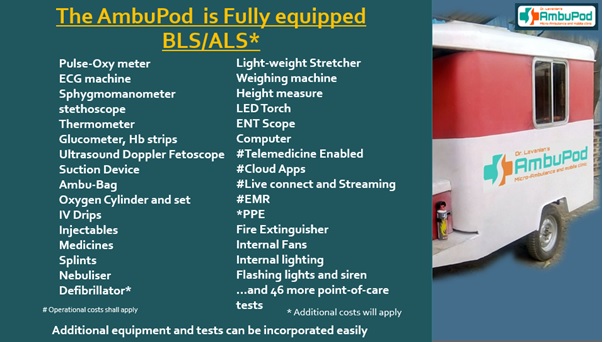
We are now reaching out to centres of excellence (CoE) to work with AmbuPod to strategize and design remote healthcare robots to carry out a remote-doctor manipulated examination of the ear, nose, throat, lungs and heart. The proposal is to look for fund providers for this project and support from CoEs for a 2 year pilot utilizing 5G connectivity.
Any organisation interested it working with us on this pilot is welcome to contact this author.
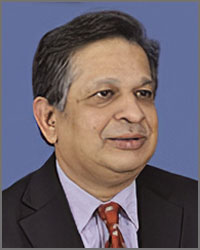 Television for Telemedicine
Television for Telemedicine
(History and Evolution of Telemedicine – 5th Milestone)
Dr. Sunil Shroff, MS, FRCS, Dip. Urol (Lond.)
President, Tamil Nadu Telemedicine Society of India,
Editor, www.medindia.net,
Consultant Urologist & Transplant Surgeon, Madras Medical Mission Hospital, Chennai, India (shroffmed@gmail.com).
Television was used in an interactive format for medical consultation in 1959 between a state mental hospital and Nebraska Psychiatric Institute through a microwave link. They actually used it for neurological examinations and other information across campus to medical students. They next explored its use for group therapy consultations, and in 1964 they established a telemedicine link with the Norfolk State Hospital (112 miles away) to provide speech therapy, neurological examinations, diagnosis of difficult psychiatric cases, case consultations, research seminars, and education and training. And slowly it was established and recognised as a powerful medium akin to face to face consultation.
However the idea of using television for such consultation emanated the first time in 1927 for a dialysis patient. The patient saw the consultant on one monitor and herself on another (See picture below).
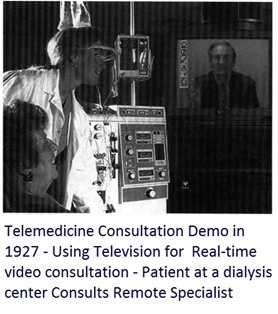
It is thought that Marshall McLuhan may have coined the term coined “telemedicine” He said “time has ceased, space has vanished, we now live in a . . . simultaneous happening. Ours is a brand new world of all onceness.” McLuhan’s argument that broadcast television, as a form of “the most recent and spectacular electrical extension of our central nervous system.”
Electronic media have been the source of a biomedical revolution as much as antibiotics, anesthetics, or organ transplants.
Telemedicine – News from India & Abroad
Apple Watch yields heart data nearly as good as clinical tests, report claims
Apple has been playing a long game in digital healthcare. The main focus – where Apple is right now – CEO Tim Cook recently said , is “…to empower people to own their health.” And as the tools to enable such ownership develop, more opportunity knocks.….. Read More
The rapid uptake of 5G and its real potential
In name it may feel like just one small step from 4G. But the fifth generation of cellular networks is much more than blazing fast mobile broadband. By: Josh Aroner, vice-president: global customer marketing at Nokia.….. Read More
Editors reserve the rights for accepting and publishing any submitted material.
TN – TSI invites all the TSI Chapters and Members to submit information on their upcoming Webinar or Events (50 words), News related to Telemedicine (200 words) or short articles (500 words) for the monthly e-newsletter. |
Editor in Chief – Dr. Sunil Shroff
Editors – Dr. Senthil Tamilarasan & Dr. Sheila John
Design – Sankara Nethralaya
Technical Partner- www.medindia.net

